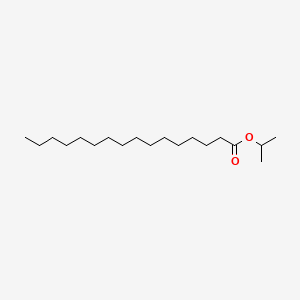



1. 142-91-6
2. Isopropyl Hexadecanoate
3. Hexadecanoic Acid, 1-methylethyl Ester
4. Isopalm
5. Deltyl Prime
6. Wickenol 111
7. Deltyl
8. Emerest 2316
9. Isopal
10. Propal
11. Tegester Isopalm
12. Ja-fa Ippkessco
13. Sinnoester Pit
14. Crodamol Ipp
15. Plymouth Ipp
16. Starfol Ipp
17. Unimate Ipp
18. Kessco Ipp
19. Emcol-ip
20. Isopropyl N-hexadecanoate
21. Stepan D-70
22. Palmitic Acid, Isopropyl Ester
23. Nikkol Ipp
24. Estol 103
25. Usaf Ke-5
26. 1-methylethyl Hexadecanoate
27. Ja-fa Ipp
28. Kessco Isopropyl Palmitate
29. Propan-2-yl Hexadecanoate
30. Hexadecanoic Acid, Isopropyl Ester
31. Hariol Ipp
32. Tegosoft P
33. Liponate Ipp
34. Lexol Ipp
35. Nsc 69169
36. Palmitic Acid Isopropyl Ester
37. 2-propyl Hexadecanoate
38. Estol 1517
39. Isopropyl Palmitate (nf)
40. Isopropyl Palmitate [nf]
41. Nsc-69169
42. 8crq2th63m
43. Chebi:84262
44. Isopropyl Ester Of Hexadecanoic Acid
45. Ncgc00164128-01
46. We(2:0(1me)/16:0)
47. Dsstox_cid_7104
48. Dsstox_rid_78312
49. Dsstox_gsid_27104
50. Cas-142-91-6
51. Hsdb 2647
52. Einecs 205-571-1
53. Mfcd00008993
54. Unii-8crq2th63m
55. Brn 1786567
56. Ai3-05733
57. Iso-propylpalmitate
58. Isopropyl-palmitate
59. Palmitic Acid Esters
60. Palmitic Acid Isopropyl
61. Radia 7200
62. Ec 205-571-1
63. 1-methylethyl Hexandecanoate
64. Schembl7743
65. Palmitic Acid-isopropyl Ester
66. 4-02-00-01167 (beilstein Handbook Reference)
67. Isopropyl Palmitate, >=90%
68. Chembl139055
69. Ipp 90
70. Dtxsid9027104
71. Isopropyl Palmitate [ii]
72. Hexadecanoic Acid Isopropyl Ester
73. Isopropyl Palmitate [hsdb]
74. Isopropyl Palmitate [inci]
75. Wln: 15voy1 & 1
76. Isopropyl Palmitate [vandf]
77. Isopropyl Palmitate [mart.]
78. Nsc69169
79. Zinc8214589
80. Tox21_112085
81. Tox21_202558
82. Isopropyl Palmitate [usp-rs]
83. Isopropyl Palmitate [who-dd]
84. Lmfa07010675
85. Akos015902011
86. Tox21_112085_1
87. Isopropyl Palmitate [ep Impurity]
88. Ncgc00164128-02
89. Ncgc00260107-01
90. Bs-15396
91. Hexadecanoic Acidisopropyl N-hexadecanoate
92. Isopropyl Palmitate [ep Monograph]
93. Isopropyl Palmitate, Technical Grade, 90%
94. Db-042654
95. Ft-0631830
96. P0005
97. 1-methylethyl Ester1-methylethyl Hexandecanoate
98. D04632
99. A885074
100. Sr-01000944752
101. J-007718
102. Q2631777
103. Sr-01000944752-1
104. Isopropyl Hexadecanoate, European Pharmacopoeia (ep) Reference Standard
105. Isopropyl Palmitate, United States Pharmacopeia (usp) Reference Standard
106. Isopropyl Palmitate, Pharmaceutical Secondary Standard; Certified Reference Material
| Molecular Weight | 298.5 g/mol |
|---|---|
| Molecular Formula | C19H38O2 |
| XLogP3 | 8.2 |
| Hydrogen Bond Donor Count | 0 |
| Hydrogen Bond Acceptor Count | 2 |
| Rotatable Bond Count | 16 |
| Exact Mass | 298.287180451 g/mol |
| Monoisotopic Mass | 298.287180451 g/mol |
| Topological Polar Surface Area | 26.3 Ų |
| Heavy Atom Count | 21 |
| Formal Charge | 0 |
| Complexity | 224 |
| Isotope Atom Count | 0 |
| Defined Atom Stereocenter Count | 0 |
| Undefined Atom Stereocenter Count | 0 |
| Defined Bond Stereocenter Count | 0 |
| Undefined Bond Stereocenter Count | 0 |
| Covalently Bonded Unit Count | 1 |
Several pharmacopoeias recommend the membrane filtration method for the sterility test of ophthalmic ointments. Isopropyl myristate, a fatty acid ester that exhibits high toxicity mainly against Gram-negative microorganisms, is indicated as a solvent for ointments.
PMID:16831530 Cardoso VM et al; J Pharm Biomed Anal 42 (5): 630-4 (2006)
... Due to their distinct advantages such as enhanced drug solubility, thermodynamic stability, facile preparation, and low cost, uses and applications of microemulsions have been numerous. Recently, there is a surge in the exploration of microemulsion for transdermal drug delivery for their ability to incorporate both hydrophilic (5-fluorouracil, apomorphine hydrochloride, diphenhydramine hydrochloride, tetracaine hydrochloride, and methotrexate) and lipophilic drugs (estradiol, finasteride, ketoprofen, meloxicam, felodipine, and triptolide) and enhance their permeation.... Besides surfactants, oils can also act as penetration enhancers (oleic acid, linoleic acid, isopropyl myristate, isopropyl palmitate, etc.). ...
PMID:19016057 Azeem A et al; Drug Dev Ind Pharm 35 (5): 525-47 (2009)
Cosmetics continue to be used by acne-prone individuals. ... The data presented were gleaned from the rabbit ear assay, which is not an ideal animal model but is the best we have. If an ingredient is negative in the rabbit ear assay, we feel it is safe on the acne-prone skin. A strong, positive ingredient or cosmetic should be avoided. Ingredient offenders include isopropyl myristate and its analogs, such as isopropyl palmitate, isopropyl isostearate, butyl stearate, isostearyl neopentanoate, myristyl myristate, decyl oleate, octyl stearate, octyl palmitate or isocetyl stearate, and new introductions by the cosmetic industry, such as propylene glycol-2 (PPG-2) myristyl propionate...
PMID:6229554 Fulton JE Jr et al; J Am Acad Dermatol 10 (1): 96-105 (1984)
Palmitic acid is a component of most animal fats, comprising up to 50% of them. The acid is normally metabolized by beta-oxidation or stored in fat deposits, as are most of the alcohol moieties after they are oxidized to fatty acids. The terminal groups of the iso-alcohols may yield acetone for excretion or for further metabolism. /Palmitic acid/
Christian M, ed; J American College of Toxicology 1 (2): 13-35 (1982)